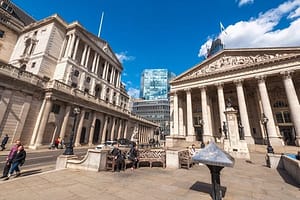It’s no surprise that the Bank of England (BoE) has followed the European Central Bank by cutting interest rates by 0.25 percentage points.
While recent UK economic data was positive with 0.5% growth in GDP in February, these are fragile green shoots.
They will need to be carefully nurtured given US tariffs could dampen business investment and consumer spending, especially when combined with the recent introduction of higher employment taxes.
These taxes will add to business costs, potentially diminishing the prospect of further investment.
Growth forecasts for the UK have already been reduced in light of the current external environment, for example, the EY Item Club has downgraded its UK growth forecast to 0.8% from 1.0% for this year and cut it to 0.9% from 1.6% for 2026.
The uncertainty resulting from recent events is clearly visible in the Bank of England’s most recent Money & Credit report. Net borrowing of consumer credit by individuals decreased to £0.9 billion, and net borrowing through credit cards was the lowest since April 2024, reflecting a lack of confidence among UK consumers to spend. Overall, the annual growth rate for all consumer credit decreased to 6.1% in March from 6.4% in February.
In fact, uncertainty and cautiousness seems to be the predominant feeling across the board, despite average wages outpacing inflation for more than 18 months. This was reflected in the report also, which showed household savings with banks and building societies increased by £7.4 billion in March, following net deposits of £5.0 billion in March.
Given the risk of overheating appears to be next-to-zero in the UK, lower rates could in fact help to stimulate demand and spur growth in the economy, as households and businesses would have more to spend since borrowing is cheaper. With US tariffs now a reality and inflation having fallen in the most recent print, it’s no wonder all signs pointed to a rate cut.
That’s despite inflation being forecast to increase to 3.7% later in the year due to higher energy costs and regulated prices. Gas and electric, water and broadband costs as well as council tax have all significantly risen in what was dubbed ‘Awful April’, which adds inflationary pressure as well as generally damaging people’s day-to-day finances. The US tariffs would be expected to add to this inflationary pressure. However, the UK is relatively less exposed to them due to its services-oriented economy, and there could be deflationary impact from other countries increasing their trade into the UK. But this is a double-edged sword as it could mean domestic industries become less competitive and the Treasury is making moves to tackle ‘dumping’ of cheaper goods.
The key question is how quickly rates fall further from here. The consensus appears to be up to 3 rate cuts this year, so it seems we’re seeing a mirror image of 2024 when rates were expected to fall more quickly at the start of the year but didn’t, while this year rates were expected to fall far more gradually than is now expected. That said, the Bank of England will need to remain vigilant to rising prices, alongside concerns about economic growth.
Consumer Impact
What’s happened?
Today we saw the Bank of England cut interest rates by a quarter of a point from 4.5% to 4.25%, a significant change from this time last year where interest rates stood at 5.25%.
Why have interest rates been cut?
Rate cuts reflect the BoE’s concerns about UK economic growth moving forward, especially after the introduction of US tariffs, which have introduced market uncertainty not just here but globally. In addition to the US tariffs, UK businesses are faced with implementing new National Minimum Wage and Living Wage rates, adjustments to statutory sick pay, and new rights related to neonatal care leave and paternity leave.
Whilst such employment changes are good news for employees, for businesses it does mean more costs to shoulder. This could impact their investment decisions and additional hiring spend could be passed down to consumers through increasing the price of goods and services.
What does it mean for consumers?
Lower interest rates are good and bad news for people – the good news is that borrowing is often cheaper with lower interest rates, so it’s cheaper to take out loans and mortgages.
However, lower interest rates are not so great for savers. Unless they have a fixed rate, the rates they receive in their savings accounts will likely decrease following this base rate change.
What should they do?
Shop around for a good savings account but be quick
It’s important savers shop around and make sure that their savings are working as hard as possible. Don’t assume your high street bank will give you a good deal, you have to do your research to find the highest interest rates! Look for a competitive interest rate, currently that’s anything above at least 4.5%. But you’ll have to act quickly as the decrease in interest rates will affect current rates on offer.
Fintechs, building societies and smaller providers are often able to be more flexible on rates and may even be offering special deals to help boost your savings.
If you have money in a regular savings account, consider putting it in an ISA
With the new financial year having started, ensure your interest is protected from tax by saving into an ISA. With best-buy Cash ISA rates well above the base rate, there’s no excuse not to be using a tax wrapper unless you’ve already maxed out your allowance.
Given the decrease in interest rates, you may want to also consider a fixed rate offer to lock in relatively higher rates. But make a point to diarise when your interest rate offer is ending if it’s for a fixed term or includes a temporary bonus so you can compare rates, especially if it’s a 3-month offer.
Mortgage holders should keep an eye out for better deals
This cut will bring some immediate relief for mortgage holders, particularly those with tracker mortgages and standard variable rates. A mortgage holder with a £250,000 mortgage and 75% loan to value will see a reduction of around £30 per month in their mortgage payments. Swap rates that influence mortgage rates have already fallen in anticipation of the Bank of England cutting rates, and some lenders have already announced mortgages with rates below 4%. New homebuyers as well as fixed rate mortgage holders whose products are coming to an end should keep an eye out for new deals hitting the market in the next few weeks, which will likely be better than what we’ve seen in the past few months.






Leave a Comment